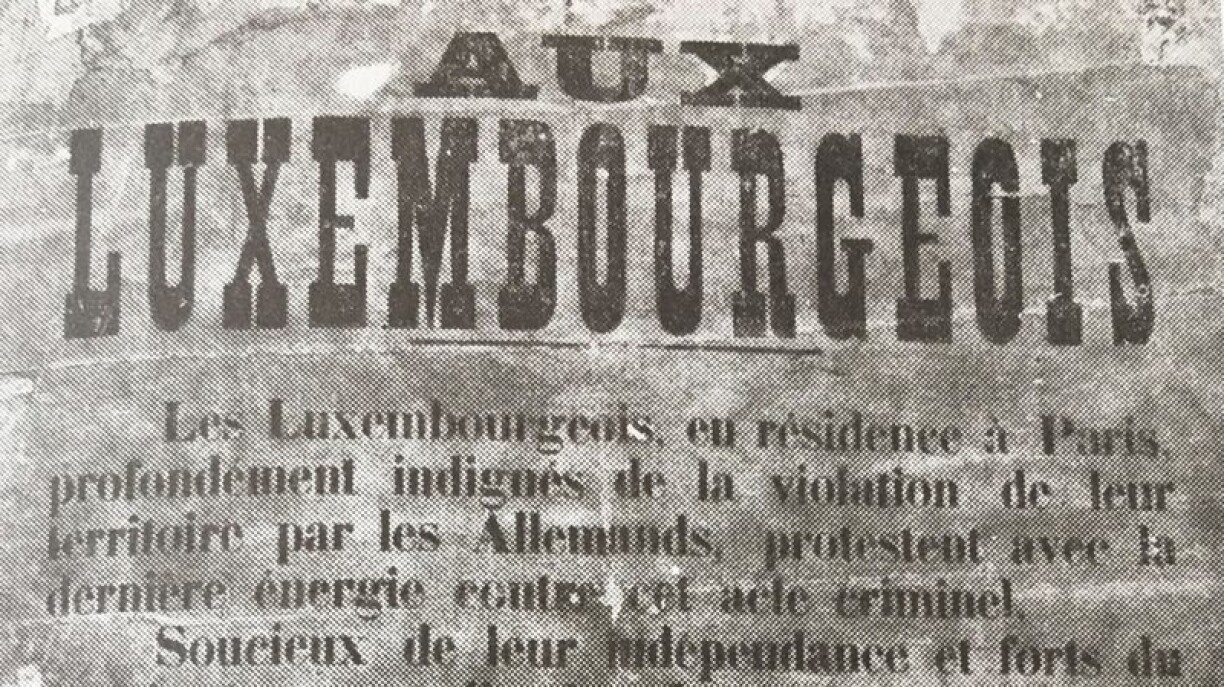
Following an initial misstep, the German Empire began its occupation of Luxembourg on 2 August 1914. Formal resistance was not an option; Grand Duchess Marie Adelaide instructed Luxembourg’s 400-man army to stand down.
While Luxembourgers under German occupation found it extremely difficult to join Allied forces, some managed to escape through Switzerland.
Those already living abroad, however, had no such issues, and thousands of young men of Luxembourgish origin would end up fighting in Allied armies from 1914 to 1918.
Listen to the episode – and more – here or continue reading below.
Probably the largest group of Luxembourgish volunteers served with the French Foreign Legion. On August 5, 1914, as Paris learned of the occupation of the Grand Duchy, an appeal to arms was launched by François Schwiesthal, a Luxembourgish resident of the French capital.
It read, “To Luxembourgers: The Luxembourgish residents of Paris, profoundly indignant at the violation of our territory, and concerned about the future of the country, will protest this criminal act with every drop of our energy. Protected of our independence and undaunted by the size of the task ahead, we Luxembourgers are invited to sign up immediately as volunteers for the profit of the great and noble French nation.”
And the appeal ended, “Vive la France! Vive le Luxembourg!” The appeal was soon published in the form of posters across the various Parisian quartiers where thousands of Luxembourgers lived. Eyewitness accounts reveal that on the day of registration, 21 August, a crowd of up to 3,000 Luxembourgers amassed at Les Invalides to sign up to fight, although some historians have argued that this number was inflated by including women and children.
On the battlefield, Luxembourgers were often split up due to the Foreign Legion’s tradition of amalgamating foreign volunteers.
Nonetheless, at the lower level, there were often opportunities for Luxembourgish soldiers to fight side by side. The 7th Company of the 1st Foreign Legion, which was heavily involved during the Battle of the Somme, was made up almost entirely of Luxembourgers.
Over a century later, there is still little agreement on just how many men of Luxembourgish origin served in the French armies, with estimates varying from 500 to around 3,000. Unsurprisingly, death totals are also unclear, although one author has listed the names of 294 Luxembourgers believed to have passed away in French service. Luxembourgers didn’t just fight for France, though.
The great wave of emigration from the Grand Duchy to the United States in the 19th and early 20th centuries ensured there was a substantial pool of young Luxembourgers, Luxembourg Americans ready to serve in the U.S. Army once President Woodrow Wilson finally declared war on Germany in 1917.
U.S. Army records from World War I feature family names such as Sigron, Evert, Clement, and Schack, all of which might be familiar to readers of our series on noteworthy Americans of Luxembourgish heritage. It’s estimated that up to 1,200 first, second, or even third-generation Luxembourgers would eventually fight in Europe with the American Expeditionary Force.
And when the Grand Duchy was finally liberated by the Americans in November 1918, some Luxembourg Americans took the opportunity to visit their ancestral homes for the first time. Among them was a Hubert H. Hostet, who spent Christmas 1918 with his grandmother near Mersch before being discharged in May 1919.
For others, though, the return to Luxembourg would not turn out so well. Corporal Peter Mauer, of Luxembourgish origin, died of pneumonia in the capital in February 1919. Mauer was one of the dozens of Luxembourg Americans who would never make it back to the U.S. after World War I, although precise numbers are, again, unknown.
The third-largest contingent of Luxembourgish volunteers served in the Belgian Army, comprising around 200 to 250 Luxembourgers. However, there were also Luxembourgers in other Allied armies during the Great War.
David Heal has identified five Luxembourgish men in the British Army, including Mathias Arendt, who died in Italy in 1918. Additionally, two Luxembourgish men enlisted in the Italian Army, and about a dozen fought with the Canadians.
The Gëlle Fra on Place de la Constitution stands as a monument to the Luxembourgers who served in World War I. Sadly, we will never know exactly how many young men of Luxembourgish origin served during the conflict, nor how many died.
The commercial success of 1917, a war epic directed by Sam Mendes, has again demonstrated our enduring fascination with the events of 1914-18. And it’s worth bearing in mind that fighting on the same side as those upper-class British generals were a generation of young Luxembourgers who fought and died to resist those who had invaded their homeland.
Thank you for tuning in! Now what are you waiting for – download and listen, on iTunes, Spotify, or wherever you get your podcasts.